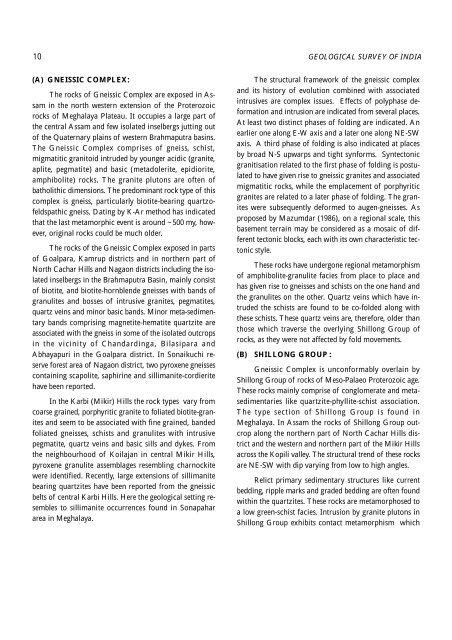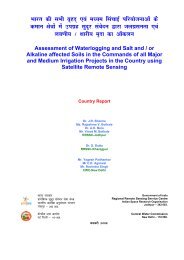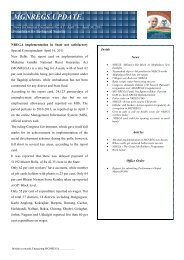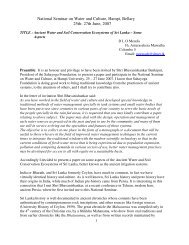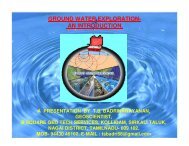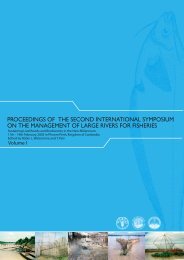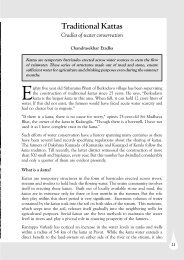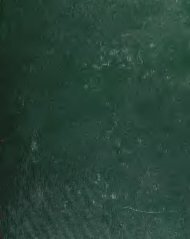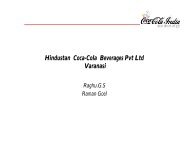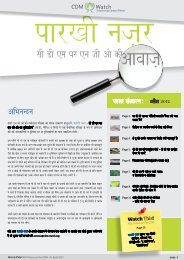Report - Assam: State Geology and Mineral Maps - India Water Portal
Report - Assam: State Geology and Mineral Maps - India Water Portal
Report - Assam: State Geology and Mineral Maps - India Water Portal
You also want an ePaper? Increase the reach of your titles
YUMPU automatically turns print PDFs into web optimized ePapers that Google loves.
10 GEOLOGICAL SURVEY OF INDIA<br />
GSI Misc. Pub. 30 Pt. 4 Vol. 2(i)<br />
(A) GNEISSIC COMPLEX:<br />
The rocks of Gneissic Complex are exposed in <strong>Assam</strong><br />
in the north western extension of the Proterozoic<br />
rocks of Meghalaya Plateau. It occupies a large part of<br />
the central <strong>Assam</strong> <strong>and</strong> few isolated inselbergs jutting out<br />
of the Quaternary plains of western Brahmaputra basins.<br />
The Gneissic Complex comprises of gneiss, schist,<br />
migmatitic granitoid intruded by younger acidic (granite,<br />
aplite, pegmatite) <strong>and</strong> basic (metadolerite, epidiorite,<br />
amphibolite) rocks. The granite plutons are often of<br />
batholithic dimensions. The predominant rock type of this<br />
complex is gneiss, particularly biotite-bearing quartzofeldspathic<br />
gneiss. Dating by K-Ar method has indicated<br />
that the last metamorphic event is around ~500 my, however,<br />
original rocks could be much older.<br />
The rocks of the Gneissic Complex exposed in parts<br />
of Goalpara, Kamrup districts <strong>and</strong> in northern part of<br />
North Cachar Hills <strong>and</strong> Nagaon districts including the isolated<br />
inselbergs in the Brahmaputra Basin, mainly consist<br />
of biotite, <strong>and</strong> biotite-hornblende gneisses with b<strong>and</strong>s of<br />
granulites <strong>and</strong> bosses of intrusive granites, pegmatites,<br />
quartz veins <strong>and</strong> minor basic b<strong>and</strong>s. Minor meta-sedimentary<br />
b<strong>and</strong>s comprising magnetite-hematite quartzite are<br />
associated with the gneiss in some of the isolated outcrops<br />
in the vicinity of Ch<strong>and</strong>ardinga, Bilasipara <strong>and</strong><br />
Abhayapuri in the Goalpara district. In Sonaikuchi reserve<br />
forest area of Nagaon district, two pyroxene gneisses<br />
containing scapolite, saphirine <strong>and</strong> sillimanite-cordierite<br />
have been reported.<br />
In the Karbi (Mikir) Hills the rock types vary from<br />
coarse grained, porphyritic granite to foliated biotite-granites<br />
<strong>and</strong> seem to be associated with fine grained, b<strong>and</strong>ed<br />
foliated gneisses, schists <strong>and</strong> granulites with intrusive<br />
pegmatite, quartz veins <strong>and</strong> basic sills <strong>and</strong> dykes. From<br />
the neighbourhood of Koilajan in central Mikir Hills,<br />
pyroxene granulite assemblages resembling charnockite<br />
were identified. Recently, large extensions of sillimanite<br />
bearing quartzites have been reported from the gneissic<br />
belts of central Karbi Hills. Here the geological setting resembles<br />
to sillimanite occurrences found in Sonapahar<br />
area in Meghalaya.<br />
The structural framework of the gneissic complex<br />
<strong>and</strong> its history of evolution combined with associated<br />
intrusives are complex issues. Effects of polyphase deformation<br />
<strong>and</strong> intrusion are indicated from several places.<br />
At least two distinct phases of folding are indicated. An<br />
earlier one along E-W axis <strong>and</strong> a later one along NE-SW<br />
axis. A third phase of folding is also indicated at places<br />
by broad N-S upwarps <strong>and</strong> tight synforms. Syntectonic<br />
granitisation related to the first phase of folding is postulated<br />
to have given rise to gneissic granites <strong>and</strong> associated<br />
migmatitic rocks, while the emplacement of porphyritic<br />
granites are related to a later phase of folding. The granites<br />
were subsequently deformed to augen-gneisses. As<br />
proposed by Mazumdar (1986), on a regional scale, this<br />
basement terrain may be considered as a mosaic of different<br />
tectonic blocks, each with its own characteristic tectonic<br />
style.<br />
These rocks have undergone regional metamorphism<br />
of amphibolite-granulite facies from place to place <strong>and</strong><br />
has given rise to gneisses <strong>and</strong> schists on the one h<strong>and</strong> <strong>and</strong><br />
the granulites on the other. Quartz veins which have intruded<br />
the schists are found to be co-folded along with<br />
these schists. These quartz veins are, therefore, older than<br />
those which traverse the overlying Shillong Group of<br />
rocks, as they were not affected by fold movements.<br />
(B) SHILLONG GROUP :<br />
Gneissic Complex is unconformably overlain by<br />
Shillong Group of rocks of Meso-Palaeo Proterozoic age.<br />
These rocks mainly comprise of conglomerate <strong>and</strong> metasedimentaries<br />
like quartzite-phyllite-schist association.<br />
The type section of Shillong Group is found in<br />
Meghalaya. In <strong>Assam</strong> the rocks of Shillong Group outcrop<br />
along the northern part of North Cachar Hills district<br />
<strong>and</strong> the western <strong>and</strong> northern part of the Mikir Hills<br />
across the Kopili valley. The structural trend of these rocks<br />
are NE-SW with dip varying from low to high angles.<br />
Relict primary sedimentary structures like current<br />
bedding, ripple marks <strong>and</strong> graded bedding are often found<br />
within the quartzites. These rocks are metamorphosed to<br />
a low green-schist facies. Intrusion by granite plutons in<br />
Shillong Group exhibits contact metamorphism which


